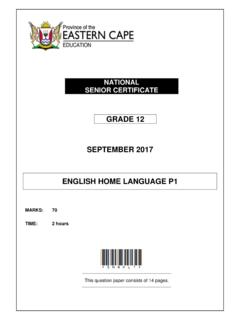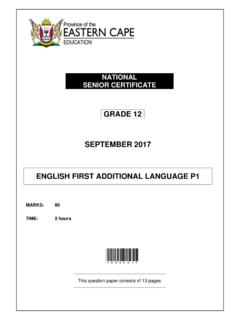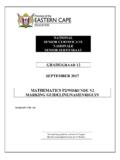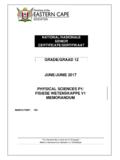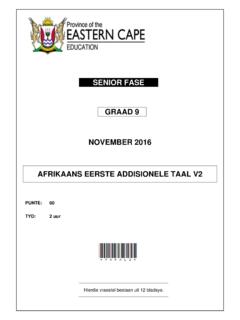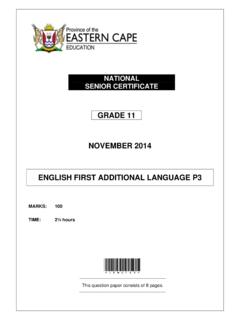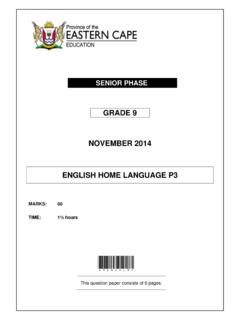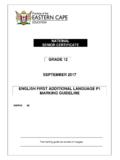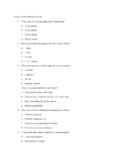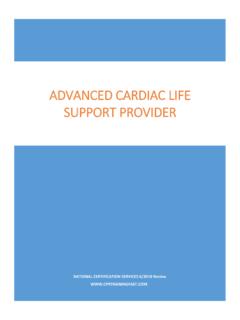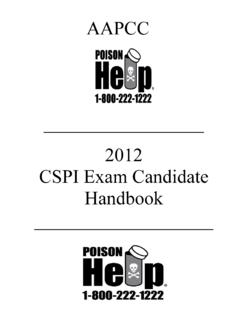Transcription of LIFE ORIENTATION - Primex
1 Copyright reserved Please turn over CAPS life ORIENTATION EXAMINATION GUIDELINES GRADE 12 2014 These guidelines consist of 7 pages. life ORIENTATION 2 DBE/2014 Examination Guidelines Copyright reserved Please turn over TABLE OF CONTENTS Page 1. Introduction 3 2. Assessment in Grade 12 4 Format of the external Common Assessment Task (CAT) 4 Cognitive levels 5 3. Content and Context Guidelines 6 4. Marking Guidelines 7 5. Conclusion 7 life ORIENTATION 3 DBE/2014 Examination Guidelines Copyright reserved Please turn over 1.
2 INTRODUCTION The Curriculum and Assessment Policy Statement (CAPS) for life ORIENTATION outlines the nature and purpose of the subject life ORIENTATION . This guides the philosophy underlying the teaching and assessment of the subject in Grade 12. The purpose of these Examination Guidelines is to: Provide clarity on the depth and scope of the content to be assessed in the Grade 12 National Senior Certificate (NSC) Examination in life ORIENTATION . Assist teachers to adequately prepare learners for the examinations. This document deals with the final Grade 12 external examinations. It does not deal in any depth with the School-Based Assessment (SBA). These Examination Guidelines should be read in conjunction with: The National Curriculum Statement (NCS) Curriculum and Assessment Policy Statement (CAPS): life ORIENTATION The National Protocol of Assessment: An addendum to the policy document, the National Senior Certificate: A qualification at Level 4 on the National Qualifications Framework (NQF), regarding the National Protocol for Assessment (Grades R 12) The national policy pertaining to the programme and promotion requirements of the National Curriculum Statement, Grades R 12 life ORIENTATION 4 DBE/2014 Examination Guidelines Copyright reserved Please turn over 2.
3 ASSESSMENT IN GRADE 12 FORMAT OF THE EXTERNAL COMMON ASSESSMENT TASK (CAT) The external Common Assessment Task will consist of a two-hour question paper of 80 marks. All topics and sub-topics in Grade 12 CAPS will be assessed, however Grade 10 and 11 content will be considered to be foundational underpinning knowledge. The examination will comprehensively address content, knowledge and skills covered from term 1 to 3 in Grade 12. More than one type of question will be incorporated and focus primarily on the application of knowledge in an integrated manner. The question paper will include content related to Physical Education. This question paper is divided into three sections: SECTIONS A and B are COMPULSORY.
4 SECTION A consists of multiple-choice questions and questions requiring short responses. SECTION B consists of two 15-mark questions to which learners must provide direct responses. SECTION C consists of three 15-mark questions of which learners must answer TWO questions. The outline below will be followed when setting life ORIENTATION question papers (CAPS). SECTION A: 20 MARKS SECTION B: 30 MARKS SECTION C: 30 MARKS All questions are compulsory. A source or case study may be used to contextualise some of the questions. The questions have to be a combination of two or more types of questions ranging from what, why, list, describe, explain, multiple choice and true or false with a justification.
5 Test understanding and factual knowledge. Responses should be short and direct and range from one word to a phrase or a full sentence(s) (in point form). All questions are compulsory. Short open-ended, scenario-based, source-based and case study questions. Questions should be knowledge-based, from information learners have acquired from the life ORIENTATION content. Learners should display, present and apply knowledge and skills gained and display an understanding of real- life issues affecting the youth and society at large and give advice or possible solutions: demonstrate goal-setting and decision-making skills. Learners should provide direct responses, full sentences in point form and extended writing in short paragraphs.
6 Three 15-mark or four 10-mark questions will be set, of which learners will be expected to answer two or three respectively. Questions will predominantly focus on the application of knowledge and skills. Learners will solve problems, make decisions and give advice, ranging from a few direct responses to extended writing of descriptive paragraphs or short essays that state, evaluate or examine an issue. Each question will focus on the specific topic or the integration of content. A short text/diagram/data/ graphs/cartoons can be provided as a stimulus. NOTE: Information provided in the texts has to be current, up to date, age appropriate and learner-friendly. Each section will include questions at lower, middle and higher cognitive levels.
7 life ORIENTATION 5 DBE/2014 Examination Guidelines Copyright reserved Please turn over COGNITIVE LEVELS The suggested weighting of the cognitive levels for the question paper is as follows: Weighting Cognitive Level Bloom's Taxonomy 30% Lower order Levels 1 & 2 40% Middle order Levels 3 & 4 30% Higher order Levels 5 & 6 Weighting of Questions In Bloom's taxonomy the same action verbs, explain, describe, compare, can be used interchangeably in different cognitive levels. It will depend on the design feature of the question to indicate whether it is a lower-, middle- or higher-order question. It must be further noted that the degree of challenge is not necessarily tied to specific cognitive levels they merely reflect thinking processes.
8 For example, although 'name' is at the lowest level of Bloom's taxonomy, many learners find recall of knowledge more difficult than evaluation, which is at the highest level of the taxonomy. Some learners are able to think creatively and synthesise material easily, while others may find it difficult. The table below provides the six categories in Bloom's taxonomy, the cognitive demands required and the action verbs associated with it. Taxonomy of thinking skills Levels of cognitive demand Category Definition * Action Words Lower order Knowledge Level 1 Ability to remember something previously learned. Tell; recite; list; memorise; remember; define; locate; name; match; recall; repeat; state; outline; write.
9 Comprehension Level 2 Demonstrate a basic understanding of concepts and curriculum. Translate to other words; recall particular information. Give examples; explain; summarise; translate; show symbols; edit; define; describe; discuss; identify; interpret. Middle order Application Level 3 Transfer knowledge learned in one situation to another. Demonstrate; use; guide; map; chart; arrange; illustrate; apply; locate; construct; solve. Analysis Level 4 Understand how parts relate to a whole. Understand structure and motive. Investigate; classify; categorise; compare; solve; relate; research; contrast; distinguish; report on; sort; debate. Higher order Evaluation Level 5 Judge value of something regarding criteria.
10 Support judgement; challenges for deeper meaning. Judge; evaluate; give opinion; viewpoint; prioritise; recommend; critique; discuss; compare; defend; assess; validate; explain; choose/decide; estimate; predict; rate/score; select; support; justify; argue; conclude; why do you think. Synthesis Level 6 Ability to remember something previously learned. Reform individual parts to make a new whole. Design; create; plan; propose; hypothesis; construct; forecast; rearrange parts; imagine; generate; compose; improve; predict; formulate; devise; examine; investigate; develop. * Some action words are interchangeable depending on the nature of the question. life ORIENTATION 6 DBE/2014 Examination Guidelines Copyright reserved Please turn over 3.
